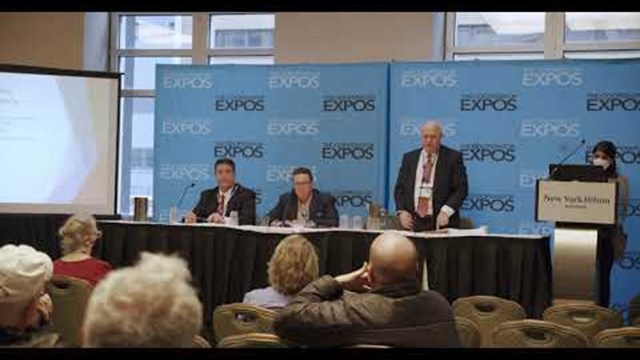Suddenly, the room was shaking and the plants around Ron Tepperman’s desk were moving—it took a second for him to register what was happening. Until a real live earthquake shook the city and created panic along the East Coast, that ground-shaking sensation was unfamiliar to most New Yorkers. The August 2011 quake only lasted about 20 seconds, and not only unnerved Tepperman and many others, but caused real physical damage to structures as well.
“It was scary,” recalls Tepperman, who is an insurance agent and president of Ron Tepperman Inc.
Even more frightening for management of some of the buildings damaged by the quake were the implications of repairing the mess. Some buildings suffered foundation cracks, which in some cases extended up many stories, taking a lot of time and money to fix.
Compared to those in the Northeast whose properties were pummeled or destroyed by Superstorm Sandy, many of the witness of the Gotham earthquake got off easy. But both recent events reminded city dwellers that they are not immune to natural catastrophes, and that it's crucial to have the right insurance coverage for their properties.
While most unit owners and board members have a good grasp of the major insurance coverages they are paying for to protect their building and property—such as homeowners, liability, and umbrella—there are more specialized types of insurance that people often are less mindful of, but which are still extremely important.
Asset Protection
The dirt, so to speak, is in the details of a building’s policy. In times of crisis, understanding that policy could be as valuable to the unit owners as knowing the community’s governing documents. But in crisis time, when the building is actively flooding, it’s way too late to get more flood coverage. You have to do it before the storm hits—long before, not just days before.
When it comes to a building’s insurance coverage, how you protect the things you need is almost as important as what you insure against losing. Some carriers are now offering “green” insurance to cover environmentally-friendly installations such as solar panels—and experts suggest adding coverage for these improvements.
“If you have anything green installed on your property, you should always tell your insurance carrier if you’ve updated with green,” says Barbara Strauss, executive vice president of York International Agency, LLC in Harrison. “If you have a replacement cash policy, you’ll get paid for green.”
Many of the criteria for green building installations are similar to those for so-called “resilient” buildings. There is an overlap between green construction and resilient construction because typically, green installations are hardy and will stand up to Mother Nature, says Lynne McChristian, the Tampa, FL-based representative of the Insurance Information Institute (I.I.I.). The nonprofit is supported by the insurance industry and teaches the public about issues surrounding insurance coverage.
Other groups also provide useful info for consumers who want to adequately protect their property. The Federal Alliance for Safe Homes (FLASH) is a consumer advocacy group promoting the strengthening of homes and safeguarding of families from natural and man-made disasters, including providing life safety and property protection advice. The group’s website has many offerings, including a “Peril Map” where residents can “Find Your Peril” and see the severe weather risks in their state.
The group’s website includes informational materials including “A Homeowner’s Insurance Guide to Natural Disasters,” “Stormstruck: A Tale of Two Homes,” and a lot more.
Extra, Extra
In New York, flood and earthquake coverage are being offered by some carriers as an enhancement to the building’s commercial package policy. But that option is dependent upon factors including the type of building, its location, the building’s particular type of construction, and the amount of insurance it already has.
While some companies include a certain amount of earthquake or flood coverage based on the value of the building, that coverage may not be enough, depending on a building's location, and more protection could be needed in these areas. Companies will charge a premium for flood or earthquake coverage, and that fee will be based upon the frequency of such events in a given coverage zone.
Regardless, it’s a smart bet to buy the extra coverage, Tepperman says. “The premium is so small that all buildings should have that coverage,” he says.
Some carriers will include flood coverage in their commercial package policies, unless the property is located in a high-risk flood zone. If the property is located in such an area, the primary flood coverage should be bought through the Federal Emergency Management Agency’s National Flood Insurance Program. The federal agency keeps maps of flood risk zones, and currently is updating those maps for the third time in four years.
Insurance through the federal program has limitations, though. FEMA coverage is limited to $250,000 for a co-op building. For a condo building, the coverage is $250,000 times the number of units.
“Properties located in flood-prone zones should buy excess flood coverage through private insurance carriers,” says Alex Seaman, senior vice president of HUB International Northeast in Woodbury. “Flood coverage can be provided at virtually any location, but is available at much higher rates in high risk zones. FEMA [flood insurance] rates are likely to increase very dramatically over the next several years, as federal government subsidies dry up.”
Buying adequate flood coverage seems like a no-brainer, so there’s no reason not to buy it. Besides, the time to get the insurance is when you don’t seem to really need it. When you do really need it, you won’t be able to get it.
“You cannot get flood insurance the day before you get the big rain. There’s a 30-day waiting period,” McChristian says.
Earthquake coverage is offered at varying limits in New York. Given the infrequency of such seismological events, costs for earthquake coverage are usually pretty cheap.
Covering the Unexpected
There also are special coverages available for building equipment, which will insure the building’s boiler, HVAC equipment, and elevator are covered in the event of catastrophic loss—like a boiler blowing up and causing damage to other parts of the building. Such policies cover equipment breakdowns of the building’s major systems, but only sudden and accidental breakdowns of the equipment.
“Remember, it’s got to be sudden and accidental. No policy covers wear-and-tear on a piece of equipment,” Strauss says. “When an adjuster comes out, these are very qualified people who will know right away if the breakdown was sudden or if it happened over a period of time.”
Still, industry pros suggest that residential buildings buy Boiler and Machinery insurance and add it to the commercial package policy. “A boiler explosion can be disastrous,” Seaman says. “It’s not terribly common, but the coverage for it is also not very expensive, and you need it.”
Another seemingly obscure, but increasingly common problem that should be insured against is sewer backups. Because of aging sewer systems and other factors, the problem of sewers backing up into a building and causing damage is becoming a real concern for some buildings. But sewer backup coverage can protect a building from this unfortunate hazard.
“Sewer backups are not covered under a typical homeowner’s insurance policy, nor are they covered by flood insurance,” says Loretta Worters, vice president of the Insurance Information Institute. “Those types of coverage must be purchased either as a separate product or as an endorsement to a homeowner’s policy.”
A sewer backup could be traced to an aging sewer system, combined pipelines, or blockages created as a result of tree roots. A sanitary main blockage that is left undetected could cause a backup into your building. While some don’t realize it, homeowners and building owners are responsible to their sewer “lateral” which connects the building’s sewer system to the main lines in the street. A break or backup in this area of the system also can be costly.
Sewer backup coverage is available for a nominal cost, and usually is just an additional premium. Most co-op and condo buildings don’t get this type of insurance, but they should, Worters says.
In the cases of homes that have been severely damaged and are uninhabitable, homeowners policies may provide Loss of Use coverage, which provides reimbursement for lodging, food and other living expenses a homeowner could incur as a result of having to live outside his or her home for a time. Loss of use coverage also reimburses the homeowner for the lost rental income, if part of the building is being rented out.
In New York City, the need to buy some types of insurance coverage may seem obvious, but apparently not to everyone. Some threats here could seem more imminent to outsiders, and be overlooked by grizzled New York City residents. Terrorism risk insurance, while less common than flood or earthquake insurance, also is available to buildings. As a result of the Terrorism Risk Insurance Act, which required all insurance carriers to offer the coverage, this type of coverage is fairly economical these days. And many lenders require it.
Other, more obscure types of insurance that boards might want to know about include crime insurance, and also Directors and Officers insurance, which provides insurance for the building in the event of problems with the board being sued.
Building Ordinance and Law coverage can insure against the increased cost of construction and demolition required by a building due to a fire or another event. In such a scenario, sometimes management must repair the building in accordance with code requirements that change the building—such as the requirement for sprinklers to be installed throughout the structure.
Perhaps the best way to protect your property and building from hazards is to know the details of your insurance policy.
“The most important thing is to know your risk. People want to live in certain places that put them in harm’s way,” McChristian says. “If you’re risk-averse, you don’t want that sea level home with that wonderful view. It’s not just about insurance—it’s about plans you make to remove yourself from those risk zones when you need to.”
For more information on the topic, visit the Insurance Information Institute’s website: www.iii.org. The Federal Alliance for Safe Homes’ website also is a good resource: www.flash.org. And to assess your risk of a flood, visit the National Flood Insurance Program website, at www.floodsmart.gov/floodsmart.
Jonathan Barnes is a freelance writer and regular contributor to The Cooperator.







Leave a Comment